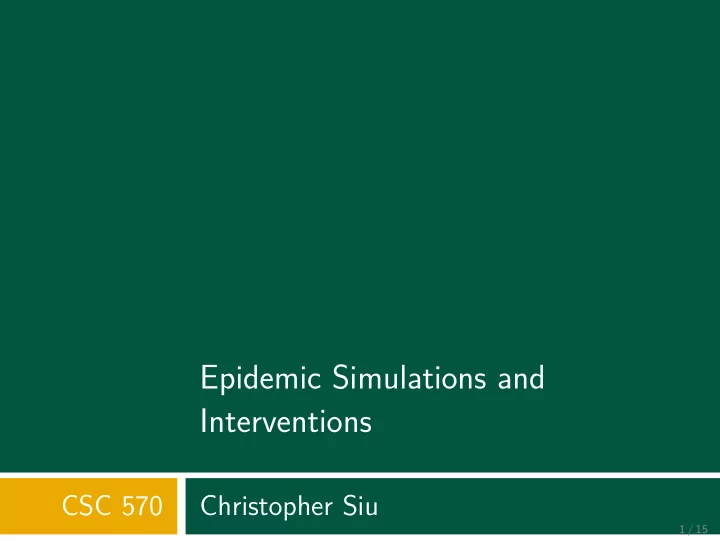

Epidemic Simulations and Interventions CSC 570 Christopher Siu 1 / 15
Mathematical Models of Epidemics Carriers R ecovered I nfected E xposed S usceptible 2 Analyze the rate of movement between compartments. 1 Compartmentalize the population based on state of infection: Cross-immunity MSIR SEIR SEIS SIRS SIR SIS SI 2 / 15 σ γ β
Mathematical Models of Epidemics Full mixing assumes all individuals have an equal chance of meeting any other individuals. Using a contact network captures individual contact events. S usceptible E xposed I nfected R ecovered 3 / 15
Mobility Patterns Contact networks must often be generated randomly, and basic models assume that contacts never change. Humans make contact consistently , but not constantly . Example (Granell and Mucha, 2018) function of mobility probability p , for varying confjgurations of individuals’ residences 4 / 15 Epidemic threshold β c as a
Temporal Networks Defjnition A temporal network is one whose structure changes over time. Assuming discrete time steps, a temporal network is a sequence of “snapshots”, samples of the network at each step. Example (Stopczynski et al. , 2014) 5 / 15
Epidemics and Interventions USSR calls for a global efgort to eradicate smallpox. Scientists recreate extinct horsepox for $100,000. 2017 Ring vaccination targets the contacts of infected individuals. Defjnition Last natural case of smallpox occurs in Somalia. 1977 1958 Graph-based models enable a more granular simulation. Parliament bans variolation, requires vaccination. 1853 Edward Jenner creates the smallpox vaccine. 1796 Example Graph-based models provide more actionable information. 6 / 15
Percolation Once an individual is immunized, they generally can neither contract nor spread the disease. Once an individual is immunized, their corresponding vertex has no efgect on the network. Defjnition Percolation is the process of removing some fraction of vertices and their incident edges. This terminology is sometimes clarifjed as “site percolation”. Specifjcally removing edges is called “bond percolation”. 7 / 15
Percolation Defjnition vertex is active in the network. cluster” tends to break apart. Example 8 / 15 The occupation probability , denoted φ , is the probability that a As φ → 0 , there is often some threshold φ c at which the “giant φ = 1 φ = 0 . 6 φ = 0
Uniform Vertex Removal The expected fraction of vertices in the “giant cluster” is: u k k k Where: 9 / 15 Theorem connected to the “giant cluster” via one of its neighbors. Let u denote the average probability that a vertex is not distribution of the network. Suppose vertices are removed with uniform probability 1 − φ . Let P = ( p 1 , p 2 , . . . , p k , . . . , p ∆ ) be the degree probability � 1 − � k p k u k � S = φ �� � ( k + 1) p k +1 u = (1 − φ ) + φ
Uniform Vertex Removal There is often no closed-form solution to these equations. These equations depend on the degree distribution. Example If P follows… k . When dealing with real-world models, we often have no control over the degree distribution or the occupation probability. 10 / 15 …a Poisson distribution, then φ c = 1 � …a geometric distribution p k = (1 − a ) a k , then φ c = 1 − a 2 a . …a power law distribution, then φ c can be very small.
H1N1: Targeted Class Closure Gemmetto, Barrat, and Cattuto (2014) simulated the spread of H1N1 in primary schools. 11 / 15 Children ( 232 ) and teachers ( 10 ) at a school in Lyon, France Contacts sampled every 20 seconds, October 1 st and 2 nd , 2009 Measured by RFID badges communicating within ≈ 1 . 5 meters
H1N1: Targeted Class Closure The Lyon dataset must be periodically repeated. Collected data represents Monday, Tuesday, Thursday, Friday. Traditional full mixing in a larger community used otherwise. Applied an SE(I/A)R model. 12 / 15 Infmuenza’s incubation period is 1 – 4 days; duration, 3 – 7 days.
H1N1: Community Movement Restrictions Frías-Martínez, Williamson, and Frías-Martínez (2011) retrospectively analyzed the spread of swine fmu in 2009. million individuals in an afgected Mexican city 13 / 15 Call Data Records provide rough times and coordinates of ≈ 2 . 4 A billion CDRs from January 1 st to May 31 st , 2009
H1N1: Community Movement Restrictions April 17 th Medical alert — noticeable decrease in mobility April 27 th Schools and universities closed May 1 st All non-essential activities closed May 6 th Restrictions lifted 14 / 15
H1N1: Community Movement Restrictions April 17 th Medical alert — noticeable decrease in mobility April 27 th Schools and universities closed May 1 st All non-essential activities closed May 6 th Restrictions lifted 15 / 15
Recommend
More recommend